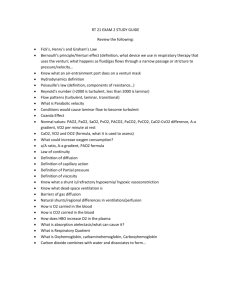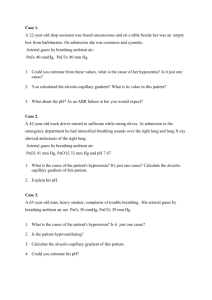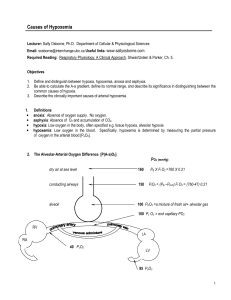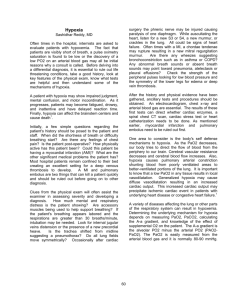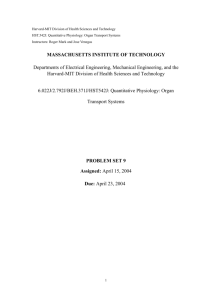Hypoxamia-and diagnostic tools
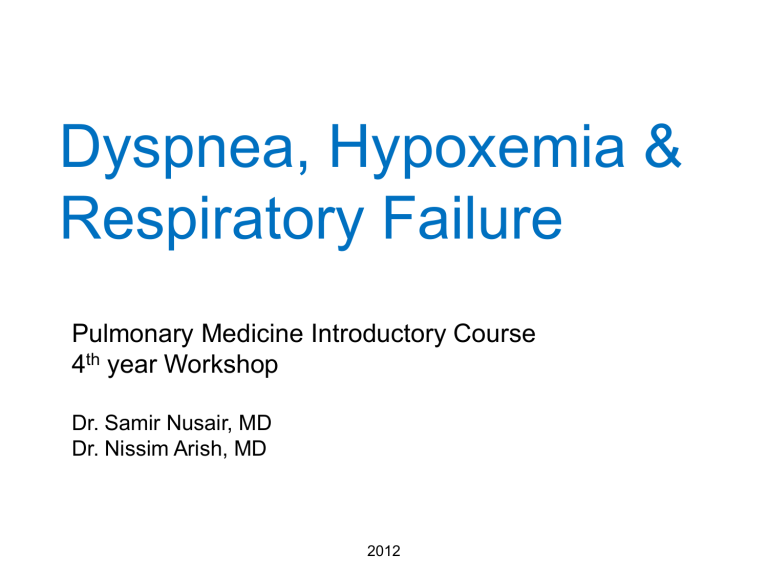
Dyspnea, Hypoxemia &
Respiratory Failure
Pulmonary Medicine Introductory Course
4 th year Workshop
Dr. Samir Nusair, MD
Dr. Nissim Arish, MD
2012
Definition:
Dyspnea is an abnormally uncomfortable awareness of breathing
ATS definition:
Subjective experience of breathing discomfort that consists of qualitatively distinct sensations that vary in intensity.
The experience derives from interactions among multiple physiological, psychological, social, and environmental factors and may induce secondary physiological and behavioral responses
2012
Differential Diagnosis of Dyspnea
Pulmonary veins
HEART
Y
LUNGS
Pulmonary arteries
2012
Approach to the Patient with Dyspnea
• History
• Physical Examination
• Diagnostic Testing
– chest x-ray
– ECG, echocardiography
– pulmonary function tests
– pulse oximetry, arterial blood gases
2012
SatO
2
vs. PaO
2
• SatO
2
– reflects the % of Hgb which binds O
2
• PaO
2
– reflects the driving pressure for oxygen in blood
• => Both factors combined determine oxygen content ) הלוכת ( in blood
2012
Hypoxia vs. Hypoxemia:
• Hypoxia: the reduction of oxygen availability in tissues
• Hypoxemia: arterial oxygen tension
(PaO
2
) < 60mmHg, or arterial oxygen saturation (SaO
2
) < 90%
2012
2012
Hypoxemia: Mechanisms
Extrapulmonary:
• Low Inspired O
2
(high altitude)
• Hypoventilation
(kyphoscoliosis, sedation)
Pulmonary:
• Ventilation Perfusion Mismatch
– Shunt
(pulmonary A-V fistula)
– Diffusion Impairment
(ILD, pulm vascular dis)
2012
Arterial Blood Gases
Normal Values
PO
2
PCO
2
75-100 mmHg
35-45 mmHg
2012
Arterial Blood Gases
Normal Values
PO
2
PCO
2
75-100 mmHg
35-45 mmHg
PO
2 on: can be expected to change depending
•Ambient conditions
•Alveolar ventilation, reflected by the PCO
2
!
2012
Alveolar-Arterial Oxygen Gradient
A-a gradient = P
A
O
2
- P a
O
2
A – Alveolar a – arterial
2012
Alveolar-Arterial Oxygen Gradient
A-a gradient = P
A
O
2
- P a
O
2
A – Alveolar a – arterial
A-a gradient is a measure of oxygen transfer at the alveolarcapillary level
2012
Alveolar Gas Equation
A-a gradient = P
A
O
2
- P a
O
2
A – Alveolar a – arterial
2012
Alveolar Gas Equation
A-a gradient = P
A
O
2
- P a
O
2
P
A
O
2
= F i
O
2 x (P
B
– P
H
2
O
) – P a
CO
2
/R
# P a
CO
2
/R reflects O
2 removal from alveoli
A – Alveolar a – arterial
F
I
O
2
– Fractional oxygen content in inspired air
P
B
- Barometric pressure
PH
2
O – Water vapor pressure
R – Respiratory quotient
2012
Alveolar Gas Equation
P
A
O
2
= F i
O
2 x (P
B
– P
H
2
O
) – P a
CO
2
/R
0.21
700 47 0.8
A – Alveolar a – arterial
F
I
O
2
– Fractional oxygen content in inspired air
P
B
- Barometric pressure
PH
2
O – Water vapor pressure
R – Respiratory quotient
2012
Alveolar Gas Equation
P
A
O
2
= 137 – P a
CO
2
/0.8
A-a gradient = 137 – P a
CO
2
/0.8 - P a
O
2
Assumptions:
1. Room air (F i
O
2
= 0.21
)
2. Altitude of Jerusalem (P
B
= 700)
3. Normal renal function (R = 0.8)
4. At rest (R = 0.8)
2012
A-a Gradient
Upper limit of normal A-a gradient =
4 + ¼ age
2012
Case #1
28 yr. old male, found lying in the street, brought in by ambulance
– PO
2
– PCO
2
65 mmHg
49 mmHg
– Sat O
2
92%
What is the A-a gradient?
2012
Case #1
28 yr. old male, found lying in the street, brought in by ambulance
– PO
2
– PCO
2
65 mmHg
49 mmHg
– Sat O
2
– A-a O
2
92%
10 mmHg (predicted = 11)
2012
Case #1
28 yr. old male, found lying in the street, brought in by ambulance
– PO
2
– PCO
2
65 mmHg
49 mmHg
– Sat O
2
– A-a O
2
92%
10 mmHg (expected = 11)
Pin-point pupils. Needle-marks on arm.
Diagnosis: heroin overdose
Treated with naloxone – excellent response
2012
Case #2
60 yr. old male, sudden onset of dyspnea
48h after hip replacement surgery
– PO
2
– PCO
2
72 mmHg
30 mmHg
– Sat O
2
94%
What is the A-a gradient?
2012
Case #2
60 yr. old male, sudden onset of dyspnea
48h after hip replacement surgery
– PO
2
– PCO
2
72 mmHg
30 mmHg
– Sat O
2
– A-a O
2
94%
27.5 mmHg (predicted=19)
2012
Case #2
60 yr. old male, sudden onset of dyspnea
48h after hip replacement surgery
– PO
2
– PCO
2
72 mmHg
30 mmHg
– Sat O
2
– A-a O
2
94%
27.5 mmHg (predicted=19)
CT Pulmonary Angiogram: multiple pulmonary emboli
2012
Case #1
– PO
2
65 mmHg
– PCO
2
– Sat O
2
49 mmHg
92%
– A-a O
2
10 (normal)
Case #2
– PO
2
72 mmHg
– PCO
2
– Sat O
2
– A-a O
2
30 mmHg
94%
27.5 (high)
Extra-pulmonary disorder: Pulmonary disorder:
Morphine
Overdose
Pulmonary
Emboli
2012
Alveolar-Arterial Oxygen Gradient:
Application
• Is hypoxemia a result of parenchymal or extraparenchymal lung disease?
• A means of follow-up
2012
Alveolar-Arterial Oxygen Gradient:
Interpretation
PO
2
, PCO
2
A-a gradient Interpretation
Normal Normal Normal
“Normal” or
Abnormal
Abnormal
Abnormal Normal
Pulmonary
Abnormality
Extrapulmonary
Abnormality
2012
Alveolar-Arterial Oxygen Gradient:
Interpretation
Causes of Increased Alveolar-Arterial
Oxygen Difference
Increased right-to-left shunt
Anatomic
Intrapulmonary
Increased ventilation-perfusion mismatch
Impaired diffusion
Increased inspired partial pressure of oxygen
Decreased mixed venous partial pressure of oxygen
Shift of oxyhemoglobin dissociation curve
2012
A-a Gradient
• F i
O
2 must be known accurately to calculate A-a gradient correctly!
• Use appropriate P
B
• R (respiratory quotient) increased in renal failure, exercise
2012
Diagnostic Procedures in Pulmonology:
Fiberoptic bronchoscopy
Pleurocentesis
Closed Pleural Biopsy
2012
Fiberoptic Bronchoscopy
2012
Fiberoptic Bronchoscopy:
Diagnostic
• Inspection of the bronchial tree
– Ostia of sub-segmental bronchi
• Bronchoalveolar lavage
• Endobronchial biopsy
– Forceps
– Brush
• Transbronchial biopsy
– Forceps (lung parenchyma)
– Needle (lymph nodes)
2012
2012
2012
2012
2012
2012
Bronchoalveolar Lavage (BAL)
• BAL serves for alveolar sampling
• Procedure:
– Bronchoscope is wedged at a distal point in the bronchial tree
– Saline is instilled through the bronchoscope
– Fluid is collected for analysis
2012
BAL fluid analysis
• Differential cell count
(normal>85% macrophages)
• Pathogens / cytological signs of infection
• Malignant cells
• Foreign Bodies (Asbestos, Silica)
2012
Diffuse Infiltrates in Immunocompromised
Host
2012
Chest 2000
2012
Fiberoptic Bronchoscopy:
Therapeutic
• Bronchial toilet
• Restoration of airway patency
– Laser photo-coagulation / resection
– Electro-cautery
– Stent deployment
– Brachy-radiotherapy
– Foreign body removal
2012
Endobronchial brachytherapy
2012
Laser photoresection
2012
Endobronchial Electrcautery
2012
Endobronchial stents
2012
Pleurocentesis
2012
Pleurocentesis
2012
Abram ’s Pleural Biopsy Needle
2012
2012
2012
2012

